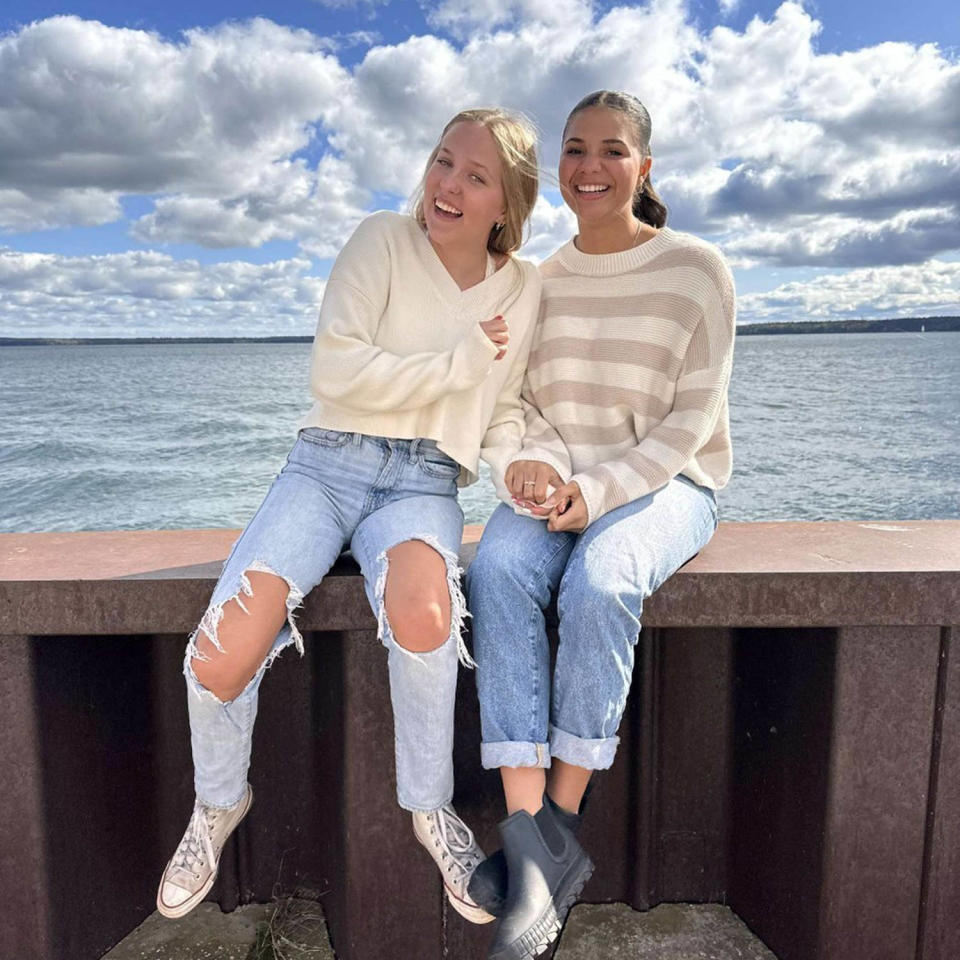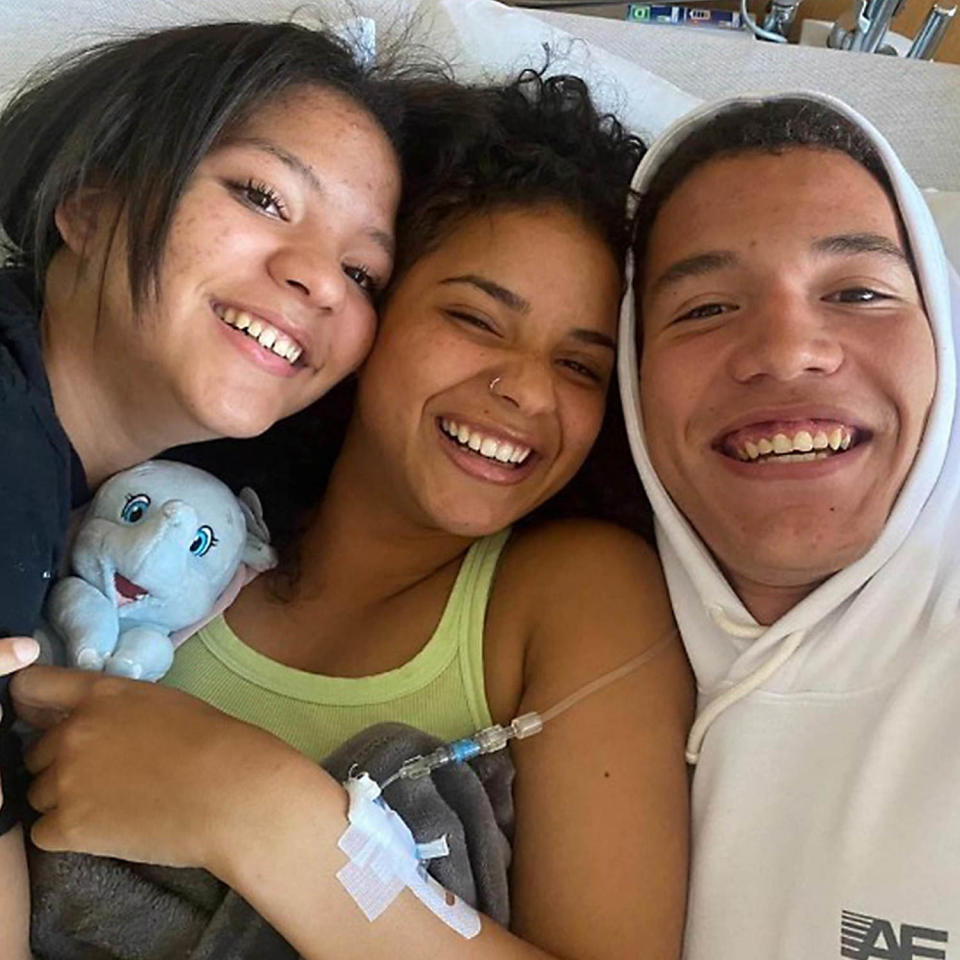In late 2022, Shimia Nord experienced such intense back pain that she failed her driver’s test. Stepmom Rikelle Hendrickson took Shimia to urgent care, where doctors said it was likely a muscle strain. While a dull pain remained, in July 2023, her symptoms intensified dramatically.
“I would throw up constantly,” Shimia, 17, of Duluth, Minnesota, tells TODAY.com. “I can barely stand, and then finally we’re like, something is seriously wrong.”
Hendrickson took Shimia to the emergency room, and they eventually learned that Shimia had renal cell carcinoma, a rare type of kidney cancer, and she’d need urgent surgery.
“You don’t really have much time to react when they’re like, ‘Oh, well, we have to get it out now,’” Hendrickson tells TODAY.com. “(I felt) scared and overwhelmed.”
Consistent back pain worsens
Before her cancer diagnosis, Shimia enjoyed sports and played soccer and volleyball for years. Three years ago, she found dance and fell in love.

“When I joined the dance team, it was like joining a family and I was always surrounded by love and support,” she says. “I (danced) six days a week from like 4 to 9:45.”When she first experienced back pain in November 2022, she was in the middle of competitive dance season. Doctors at urgent care thought it was a pulled muscle. The family had also recently recovered from COVID-19, so doctors took images of Shimia’s chest to make sure she didn’t have a pulmonary embolism, when a blood clot gets stuck in an artery in the lungs.
“They did some testing for that, and sent her home with lidocaine patches,” Hendrickson explains. “They didn’t find anything … because (the images were) higher than where her kidneys were.”
Shimia returned to dance and school with a constant twinge in her side. By Fourth of July weekend 2023, though, the pain worsened, and she was vomiting. They went to the emergency room.
Doctors ran tests and noticed something on Shimia’s kidney and said it was inflamed. They wanted her to go to Children’s Minnesota Hospital for follow-up care. On the drive there, Shimia read the paperwork and saw she had “a tumor they suspected was cancerous.” After they arrived, doctors told the family the mass needed to be removed immediately.
“They still couldn’t say for sure what it was because they hadn’t been able to test it,” Hendrickson says. “They told us from looking at the scans that they were thinking that it was renal cell carcinoma, but there wasn’t a way to say that for sure until they actually got it out.”
But they knew the mass was “large enough that the tumor had to come out with her whole kidney.” This news felt ominous.
“I was terrified,” Shimia says. “When I was in 10th grade, we were talking about our biggest fears health-wise and mine was literally getting cancer. To hear it was really scary for me.”
Surgery went well, and she was diagnosed with stage 2 papillary renal cell carcinoma.
“They said they were able to remove the tumor that was encapsulated,” Hendrickson says. “They did remove (some) lymph nodes.”
Shimia had an incision that ran from her breastbone to her pubic bone that caused intense pain that immobilized her.
“She didn’t want to get up. She didn’t want to eat,” Hendrickson says. “She was refusing to do a lot of things.”
After a few days — and a few bribes of friend visits — Hendrickson convinced Shimia to walk and shower. By July 11, she was able to go home.
When the pathology results returned, doctors believed they removed all the cancerous spots and recommended surveillance every three months. At the first three-month scan, doctors noticed spots in Shimia’s lungs. They continued monitoring it for another six weeks, but by December, it became clear the spots were growing. After testing her lymph nodes, doctors realized Shimia’s cancer had progressed to stage 4.
“It did change the treatment plan dramatically at that point,” Hendrickson says.


She’s receiving immunotherapy and chemotherapy to treat her cancer. She experiences nausea, constipation and headaches from the treatment.
“It’s like one pill after another just to make the other pill not seem so bad,” Shimia says.
Shimia recently began her new treatment plan and will undergo a scan in a few months to see if the masses in her left lung are shrinking. Future treatment will depend on how well this protocol works, but Self says she will continue to consult with her colleagues to help Shimia have the best outcome possible.
Renal cancer in young adults
The type of cancer Shimia has, renal cell carcinoma, remains rare in a pediatric population, Dr. Chelsea Self says.
“In general, there are probably somewhere around 600ish new pediatric renal cancers … diagnosed every year, and only about 3% to 4% of them are renal cell carcinomas,” the pediatric hematology oncologist at Children’s Minnesota tells TODAY.com. “It’s relatively uncommon.”
Self, who is Shimia’s oncologist, worked with other doctors, including adult oncologists, to create a treatment plan that works for the teen. It’s part of the Adolescent and Young Adult Oncology program, which treats patients from 15 up to 30.
“Some of the cancers diagnosed behave more like pediatric cancers,” Self explains. “Some certainly behave more like adult cancers, and that’s why it’s so important to collaborate with our adult counterparts and figure out what we need to do to optimize care for each patient.”
Self says symptoms of kidney cancer can include:
Side or flank pain
Back pain
Blood in urine
Nausea
Vomiting
Unexplained weight loss
Fatigue
Bump on the side
“These (symptoms) are more generally for any kind of cancer diagnosis,” Self says. “But really the flank pain, the lump on the side … is more tailored toward something going on in the kidneys.”
Treatment usually involves surgery to remove the mass and often the kidney, she says. If cancer any remains, the treatment can vary to include chemotherapy or immunotherapy. While back pain remains a common symptom, Self wants to reassure parents that not all back pain is a sign of cancer.
“It is so unfortunate what happened to Shimia, but I would remind parents that this is exceedingly rare,” she says. “I would also probably remind families that it highlights the importance of having a good relationship with your general pediatrician and making sure you’re doing all your well child checks and you are able to call them and be evaluated if you have concerns.”
High school and cancer treatment
Some days, cancer treatment makes Shimia feel lousy. But she has activities she wants to do so she persists.
“I still have so much to do, so even if I’m tired or I don’t feel as well, I still try to do everything even feeling crappy and pretend I’m not,” she says.


Shimia recently danced again, the first time she’d done it since undergoing a lung biopsy after the scan found the spots in her lung.
“It was really tiring,” she says. “It was hard because it’s the first time I’ve ever done any endurance since before the bronchoscopy.”
Shimia hopes to become a lawyer and takes college classes so she can graduate college early and head to law school. The love she’s received from friends and family helps her as she juggles high school and cancer treatment.
“I’ve always been lucky to have a supportive family,” she says. “Not everybody does.”
Hendrickson feels impressed by Shimia’s strength.
“She had her kidney removed in July and was back dancing before school started. Her resilience to me is just amazing,” she says. “To watch her do the things she loves and push through everything that’s she been doing now, lots of adults can’t do it. I’m so incredibly proud of her.”
This article was originally published on TODAY.com











